
A frontier near the huge Cambo and Rosebank fields in the West of Shetland has been left “underexplored” according to a new study.
The Aberdeen University-led project found that a lack of exploration and research has led to poor understanding of the Corona Ridge region, with untapped potential.
But the report suggests a new approach which could help develop complex fields like Rosebank, and tap into a “stranded” 100 million barrels of oil equivalent and 656 billion cubic feet of gas in the area.
Unlike the neighbouring Rona Ridge, where BP’s giant Clair field and Hurricane Energy’s Lancaster have been developed, none of the Corona Ridge discoveries have yet been sanctioned.
That’s despite Cambo and Rosebank holding combined recoverable resources of more than 700 million barrels of oil equivalent (mboe).
The West of Shetland is one of the areas which has acreage of offer in the North Sea Transition Authority (NSTA) 33rd offshore licensing round launched today.
Knowledge gaps
The report hones into the central-northern region of Corona Ridge, where exploration over the last twenty years has not been focused (it has instead been clustered in the south, near Rosebank).
Many of the wells which have been drilled were done so in the late 90s and early 2000s, prior to key advancements of understanding of the Corona Ridge geology.
The problem has been exacerbated by lava cover in the region, impacting seismic imaging.
Findings
Using info from the NSTA’s National Data Repository, the report has made a series of findings on the structural configuration, geology and hydrocarbon prospectivity of the central-northern Corona Ridge.
That includes showing the existence of an extension to the Rosebank petroleum play beneath the basalt lava to the north-east, along the central-northern Corona Ridge.
It also “challenges the previous understanding” of the region’s geology, with some areas having been mistaken for Triassic strata – which are typically “barren” of microfossils.
This suggestion opens up more exploration plays in the Corona Ridge which, with 3D seismic data, has been shown to be “far more complex” than previously understood.
Recommendations
The report authors used data from a series of wells, such as the potentially “under-appraised” Eriboll well drilled in the 1990s, to make their findings.
They underline the need to re-evaluate wells drilled in the northern Corona Ridge like Bunnehaven and Tobermory, which combined make up the 656 bcf stranded gas figure.
Underscoring the importance of the work, the authors said: “The Faroe–Shetland Basin (FSB), located west of the Shetland Isles on the NE Atlantic continental margin, is one of the only remaining significant exploration frontiers on the UK Continental Shelf (UKCS), and will also arguably be one of the most important areas to contribute to indigenous oil and gas supply in the next 40 years.”
Recommended for you

